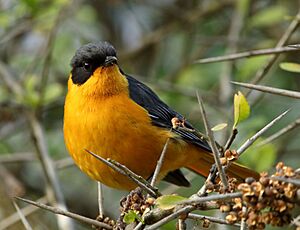Chorister robin-chat facts for kids
Quick facts for kids Chorister robin-chat |
|
|---|---|
 |
|
| Conservation status | |
| Scientific classification | |
| Genus: |
Cossypha
|
| Species: |
dichroa
|
The chorister robin-chat (Cossypha dichroa) is a beautiful bird. It belongs to the Old World flycatcher family, called Muscicapidae. You can find this bird in South Africa and Eswatini. Its home stretches from the southern Western Cape through the Eastern Cape, KwaZulu-Natal, and Mpumalanga to northern Limpopo. This bird loves evergreen forests, especially in misty areas. It is known for its lovely songs, which sound like a choir!
Contents
About the Chorister Robin-Chat
The chorister robin-chat was first officially described in 1789. A German scientist named Johann Friedrich Gmelin gave it its scientific name. Today, this bird is placed in a group of birds called Cossypha. There are two slightly different types, or subspecies, of the chorister robin-chat. One lives in Eswatini and southern South Africa. The other lives in northern South Africa.
What Does It Look Like?
This is a fairly large robin-chat. It grows to about 20 centimeters (about 8 inches) long. You can easily spot it by its dark upper body. This includes its face, head, neck, and back. Its belly and chest are a bright yellow-orange color. Unlike some other birds, it does not have a white stripe above its eye. Young chorister robin-chats look a bit different. They are sooty and mottled with a tawny-buff color. Their tail is red-orange with a dark center.
How Do They Behave?
Finding Food
The chorister robin-chat usually likes to be alone. It looks for food high up in the forest trees. It picks insects off leaves. But from April to September, when they are not breeding, they might also look for food on the ground. Their main diet includes insects, millipedes, spiders, and ticks. They also eat fruit during the non-breeding season.
Raising Young
Chorister robin-chats breed from October to early January. The female bird builds an open, cup-shaped nest. She usually places it less than 5 meters (about 16 feet) off the ground. She often chooses a hole or crack in a tree trunk. Sometimes, the nest might even be on the ground.
A female bird lays about three eggs at a time. The eggs can be pale blue, blue-green, olive-green, or olive-brown. Sometimes, they have dark spots. The eggs are kept warm for about 15 to 19 days. After hatching, the young birds leave the nest in about 14 to 15 days. But they stay with their parents for up to six more weeks.


